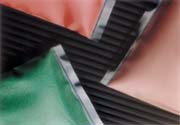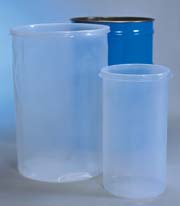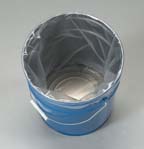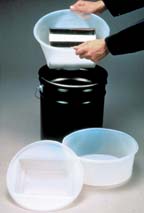
The choice to use a plastic liner in conjunction with the pails and/or drums being used currently in plant operations or product packaging applications can save money, reduce waste, and protect product integrity throughout the lifespan of that product's containment in its original packaging.
While both pail and drum liners were originally conceived as components in the packaging of products such as adhesives and sealants, they have morphed into popular MRO tools used in plant settings to reduce costs related to the use and replacement of costly new pails and drums for in-plant applications.

- Round-bottom film liner: Cylindrical and ranging in sizes from 5 to 55 gal, these liners feature a circular disc on the bottom to permit a perfect fit in the bottom of cylindrical containers. This fit minimizes wrinkling and eliminates the folds and air pockets that contribute to fatigue and failure in non-cylindrical liners. Constructed of LDPE with a variety of thickness options, these same liners can also be made from high-density polyethylene. An economical alternative to round-bottom film liners is the "flat seal bag," featuring a cut and fold design that provides superior seal integrity, uniformity, and strength over ordinary "roll-tear" or "perforated-edge" style bags.
- Semi-rigid drum liner: Cylindrical and fitting the contour of a drum the same way a round-bottom film liner does, this liner design is heavier and more rugged than the film version. This design eliminates concerns where mixing paddles or other devices are used in processing operations. Vacuum-formed from a blend of low and linear low-density polyethylene, this liner is available in a variety of sizes and thicknesses.
- Pail liner: Typically available in a range of sizes from 2 to 6 gal, this liner can be used for in-plant applications where either steel or plastic pails are in common use. A disposable liner, it keeps a finite number of pails in continuous service while eliminating costs associated with cleaning and/or replacing used pails. While most liners in this segment are constructed of HDPE for use as both an in-plant productivity booster and a shipping package component, low-density liners are also available to work in conjunction with plastic pails for product shipping applications.


- Pail Divider: This is a high-density polyethylene insert for 5- and 6-gal steel pails that allows shipment of two-components in one container. It is available in two versions: cradle and tray. The shape of the cradle model provides support for a 1-gal can in an upright position. The tray style is a flat-bottom plastic pan supported by the top rim of a steel pail in the same manner as the cradle.
- Drum Protector Lid: Drum protector lids (DPLs) are polyethylene lids designed to protect the head of a TH and/or FOH steel drum and its fittings from contamination or the elements. DPLs are also popular as temporary covers for partially filled drums during plant processing applications. Available in black in either TH or FOH models, this product also comes in a clear option to allow for easy reading of identifying marks or labels placed on drum heads. Applying the lid takes just seconds, and consistent use can extensively prolong the lifespan of steel drum heads.

Liner products (such as those listed above) allow for rapid changeovers, eliminate cleanup time, speed production, boost productivity and heighten profit. With the prices of both plastic and steel containers rising, replenishing even a small inventory of pails or drums for use within a plant setting can be costly. Furthermore, companies presently washing out existing inventories of pails and/or drums for reuse must tackle the issue of labor costs involved in such a process, along with the proper disposal of sewage generated by these clean and reuse methods.

- Cleaning of used pails or drums is no longer necessary.
- Overhead involved in the cleaning process is eliminated or reassigned.
- Concerns about contamination of the waste stream from your facility are removed.
- No need to purchase costly replacement pails or drums, which can take up valuable space within a facility.
- Changeovers become quicker and boost the output of production lines with the use of a simple productivity tool, like a pail or drum liner.
As such, the cost justification for liners is immediate in that these liner products are always less expensive than the pails or drums normally purchased as part of plant operation needs. Moreover, their presence ensures heightened productivity, which goes right to your company's bottom line both now and in the future.
As this article noted at the outset, the advent of poly liners and their use as a packaging component was the first, more obvious application. While the use of liners for in-plant applications has grown significantly, the original use of these products has not been diminished: the use of plastic liners as part of a product packaging application is a value-added strategy that can provide significant advantages to the marketplace. Liners can help ensure maximum recovery of package contents, ease the reuse possibilities of containers such as steel and poly pails and drums, and greatly benefit the environment.
While a good liner vendor should have a multitude of products to meet the array of applications in your operations, not every "standard" liner fits the bill. Is your vendor up to the challenge of meeting custom requirements when the need arises? Can they rise to the challenge of a custom application while respecting your development timeline and budget parameters? If the answer to the above questions is yes, then you can feel secure about your liner resource choice and move forward in the knowledge that the introduction of plastic liners into your plant and/or shipping applications will save your company money in a variety of ways, as well as ensure the safe transport and use of your product by your customers and end users.
For more information, contact Guy S. Shipley at (800) 638-1012, ext. 224 or e-mail gshipley@hedwin.com .
Consider This
If you've reviewed the option of using liners as either packaging components or as in-plant productivity tools and are ready to move on to a review of your options, your checklist may include the following items.- Does your liner supplier use its own internally produced sheeting and film in constructing their product? This ensures the highest quality standards are met throughout the manufacturing process.
- Is your vendor ISO 9001 certified in both the design and manufacture of its products? At the least, does your liner source use some sort of continuous improvement process that focuses on meeting or exceeding its customers' quality standards at all times? What other programs does a potential vendor bring to the table that demonstrate its ongoing commitment to meeting your organization's quality and cost objectives?
- Does the supplier feature a skilled staff of engineering and/or technical services personnel that can help its customers sort out complicated shipping and regulatory matters without burdening their internal resources?
- Does the company have a reliable distribution network where product can be easily and conveniently accessed in the event you or your staff needs to source product closer to your facility?
